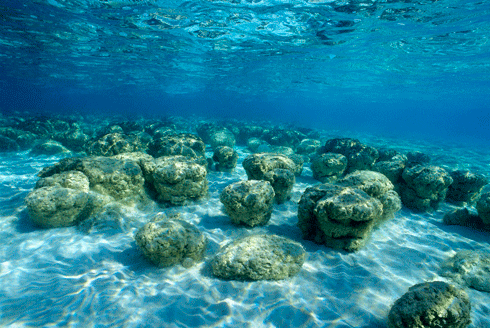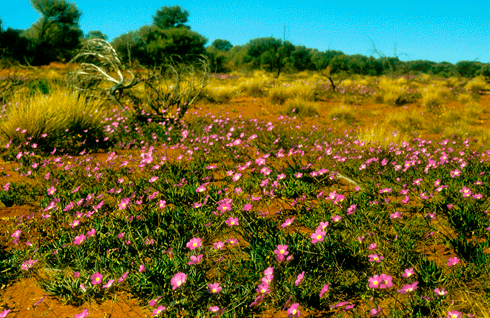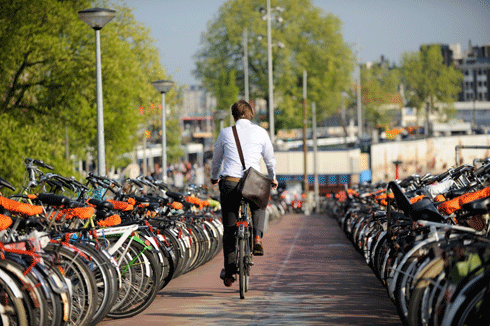
|
Published: 4 July 2011
Meeting challenges at the energy–water–carbon interface
The linkages between energy, water and carbon emissions run deep, and call for new ways of thinking about people and their environment. For example, desalination plants guzzle energy, and forests planted to sequester carbon reduce river flows. CSIRO climate expert, Dr Michael Raupach, shares some holistic, integrative approaches to humankind’s use of energy, water and carbon.

|
|
Stromatolites in Western Australia: a living reminder of the carbon-based life forms that emerged on Earth almost 3 billion years ago. Credit: © Gary Bell/OceanwideImages.com
|
Energy, water and carbon are literally the cradle of life. About three-and-a-half billion years ago, on an Earth very different from the one we now inhabit, carbon-based molecules in a water environment started using energy to become organised and reproduce. Life emerged and biotic evolution began.
Through the dizzying expanse of time since then, about 20 major ‘emergences’ have occurred in the evolutionary chain, from single cells through to multicellular organisms, vertebrates and us.1 Each emergence created new forms, which were much more than the sum of their parts; just as a body is much more than a jumbled mass of cells. Each emergence thus defines a volume in the great library that tells the story of the evolution of life on Earth. The story is vast and complex, but is based throughout on the dance between energy, water and carbon.
This 3.5-billion-year perspective is unlikely to have been in the minds of government ministers and policy makers when in 2009, they charged the Prime Minister’s Science, Engineering and Innovation Council (PMSEIC) to report on ‘Challenges at Energy–Water–Carbon Intersections’. Their concerns were articulated in the language of a quite different story: the difficult policy issues posed by climate change, sharing of limited water resources and security of energy supplies.
I was part of the working group charged with reporting to the PMSEIC on the energy–water–carbon challenge.2 The report recognises that Australia has to cope with erratic natural water supplies – which are already being fully used in many regions – while needing to produce more food and to safeguard a fragile environment. Along with the rest of the world, we also need to respond to climate change caused by increasing greenhouse gas emissions. Humankind needs to reduce its dependence on cheap oil, gas and coal over the next few decades. This is not only because fossil fuel combustion is the single largest contributor to climate change, but also because fuel reserves will deplete – soon, in the case of oil.

|
| Figure 1: |
Figure 1 maps some of the many important intersections between energy, water and carbon, and their connections with the natural world and with human societies. For example, energy generation by almost every technology requires water in industrial quantities. Urban water supplies require energy, particularly for sources such as desalination and recycling. With our present fossil fuel-intensive energy infrastructure, more energy consumption means more greenhouse gas emissions, further exacerbating climate change and variability.
Highly connected networks tend to propagate and amplify instabilities through spreading ‘ripple effects’. This is because everything potentially influences and feeds back upon everything else. Examples include the human and economic consequences of natural disasters, oil crises, and the effects of climate variability and change on water supplies and rural economies.
These considerations go to the heart of the energy–water–carbon challenge for Australia. We need to find connected energy–water–carbon pathways that respect environmental constraints on water availability and greenhouse gas emissions, and that combine social wellbeing, economic sufficiency and environmental sustainability – all in the presence of domestic and global uncertainties and shocks.
As Figure 1 indicates, this challenge is influenced by factors beyond energy, water and carbon. In particular, population and economic growth are both critical. Not all possible future Australian population trajectories or scenarios for future economic growth can support an effective response to the energy–water–carbon challenge.
A challenge of such breadth demands an integrative perspective. If we try to fix particular problems piecemeal instead of viewing the connected system as a whole, we chance making things worse somewhere else. How can we unify and simplify this thicket of connections in a way that facilitates sensible action?
One key idea is resilience, a powerful concept that is the focus of much active research and practice.3
From this body of work, three critical attributes of a resilient system can be identified.
-
The system can recover from disturbances and shocks. A resilient system can bounce back, though not necessarily by repeating its past. For example, desert ecosystems that green up after rain are resilient, but towns that collapse with the loss of their major industry are not. Resilient agricultural production systems and urban water systems can survive shocks from droughts, floods and shifts in climate.
-
The system can adapt. A resilient system can evolve new ways of doing things. For example, the best farmers are continually experimenting and improving farming practices. Likewise, innovation is fundamental to business success in a shifting environment.
-
The system can undergo transformation when necessary. Sometimes, evolutionary survival requires a system to transform itself into something new. For example, existing print media and publishing ventures face the need to reinvent themselves to survive in a world of online information and social media. Fossil fuel-based energy systems need to transform to survive in a carbon-constrained future. Transformation is difficult and costly, as it involves leaving comfort zones behind, unlearning old patterns, and accepting losses in present efficiency in exchange for long-term effectiveness.
The concept of evolution is central to the idea of resilience. Evolution drives the emergence of complexity in life as well as in societies, economies and technologies.4

|
|
Desert plants that survive long periods of drought but reappear after rare rain events are an example of resilience in the face of change. Credit: ScienceImage
|
In all these domains, evolution works by a deceptively simple algorithm with three steps:
-
diversification: trying many new possible forms
-
selection: identifying which forms work best
-
amplification: allowing the selected forms to flourish.
In biological evolution, the diversification is genetic and the selection and amplification occur through natural selection. This was Darwin’s great insight. In societies, economies and technologies, diversification occurs by experimentation and innovation, while selection and amplification in free enterprise economies occur through market forces with governance of the commons.

|
|
Amsterdam has led the way in urban design that maximises access for bicycles – bikes parked outside an Amsterdam train station. Credit: istockphoto
|
This was the framework the Working Group used to arrive at five recommendations in the PMSEIC report. The recommendations span traditional sectors, and focus on developing the knowledge, systems and approaches needed to address energy–water–carbon challenges that will demand long-term transformations, rather than advocating particular solutions.
Broadly, the recommendations are:
-
Implementation of consistent principles for finite resource use, jointly applicable to energy, water and carbon. The purpose of these principles is to ensure that markets transmit full, linked, long-term costs of energy, water and carbon to society; accounting is comprehensive and consistent with natural constraints and processes; and markets work together with non-market strategies, including robust governance arrangements, behavioural change and effective regulation.
-
Design, testing and assessment of linked ‘smart networks’ for electricity, gas and water, through a research and implementation program leading to commercial demonstration. This will improve distribution efficiency and facilitate behavioural change.
-
A national ‘Resilient Landscapes’ initiative, to support the evolution of land systems as resilient producers, water catchments, carbon storages, ecosystems and societies. This is a long-term, transformational initiative aimed at fostering an integrative approach to the multiple challenges of producing more food with less water, reducing greenhouse gas emissions, restoring stressed land and river ecosystems, and improving the social and economic viability of rural communities.
-
A national ‘Resilient Cities and Towns’ initiative is the urban counterpart of recommendation 3, and is similarly long-term and transformational in intent. This initiative aims to foster resilient, low-emission energy systems, water systems and built environments, by focusing jointly on technological developments in supply and on adaptation in demand as Australia’s urban populations grow.
-
Enhanced knowledge and learning system. This focuses on the new knowledge and innovation required to empower the evolutionary engine of diversification, selection and amplification. There is a particular need for integrative understanding of whole-system behaviours to close a growing gap between the compartmentalised knowledge provided by our current innovation system and the cross-disciplinary, cross-sectoral understanding needed to enable innovation across energy, water, carbon and related domains.
|
The PMSEIC working group’s Resilient Cities and Towns initiative provides one example of how water, energy and carbon considerations might be integrated into coherent policy. |
The initiative aims to ‘foster resilient, low-emission energy systems, water systems and built environments (from major cities to small towns) by focusing on technological developments in supply and on adaptation in demand as the Australian urban population grows’. |
This could be achieved through efficiency, conservation and demand management measures such as reshaping energy and water supply, and recycling energy, water and carbon resources presently discarded as waste. |
Specific activities might include: |
|
Policy development and implementation would involve local governments, federal and state regulatory agencies, energy producers and retailers, energy innovators (eg for smart networks), the building industry, urban planners and architects, the education sector, the research community (government, university and private) and community organisations representing special needs such as homelessness and aged care. |
Dr Michael Raupach is a CSIRO Fellow and Co-Chair of the Global Carbon Project, an international effort to improve our understanding of the global carbon cycle.
1 Harold Morowitz, one of the profound thinkers in the biological sciences, identified 28 emergences – from the birth of the universe to the emergence of contemporary human societies. Twenty of these occurred in the journey of life from its inception to the present. See Morowitz HJ (2002). The Emergence of Everything. Oxford University Press.
2 tinyurl.com/energy-water-carbon
3 See for example the Resilience Alliance: www.resalliance.org
4 A wonderful account of evolution as a universal algorithm is given in Dennett DC (1995). Darwin’s Dangerous Idea. Penguin. The fundamental role of evolution in economic emergence is developed in Beinhocker ED (2006). The Origin of Wealth. Harvard Business School Publishing.



